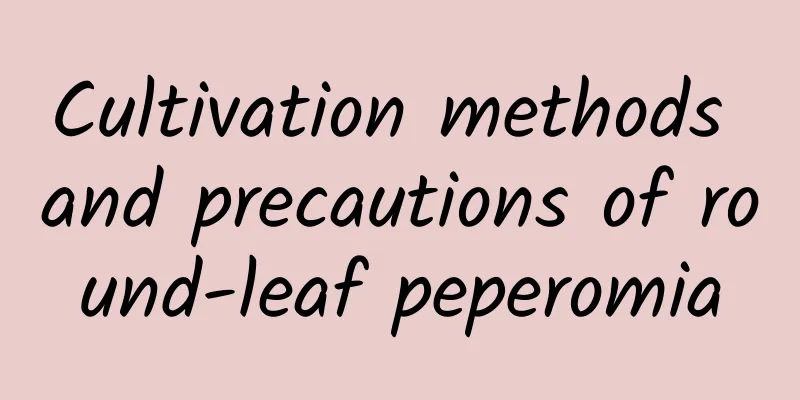Cultivation methods and precautions of cliff chrysanthemum

1. Maintenance methods1. Soil: Cliff chrysanthemum needs a relatively comfortable environment during its growth process, and the soil environment required is particularly important. During the planting process, we need to provide it with slightly acidic soil and add some animal manure to make the soil more fertile. 2. Light: It should be placed in a sunny and well-ventilated place for cultivation, and try to keep the light time for more than ten hours. If the lighting time cannot be achieved, artificial lighting may be required. Except for the summer when the light is too strong, it can be placed in the sun at other times. 3. Temperature: The temperature requirement of cliff chrysanthemum is not very high. In the north, the outdoor temperature is low in winter, so it should be placed next to the heater in the north. In some southern regions, the most suitable temperature for indoor cultivation is around 10 degrees. 4. Water: Water is particularly important for the growth of cliff chrysanthemum. The amount of water required each year varies depending on the season and its growth cycle. During its early stages, since the roots absorb less water, the amount of watering should be reduced appropriately and the soil should just be moist. In the north, due to low precipitation and dry air, more watering should be done according to soil conditions. In the south, which is generally humid, the opposite treatment can be applied according to individual conditions. 2. Breeding techniques1. Pinching: You can pinch the base, middle or top of the plant according to your own cultivation preferences. If you want the plant to have more branches and flowers, you can pinch the side branches several times to make it have more branches and increase its ornamental value. 2. Reproduction: Cutting propagation is mostly used. The cutting materials are generally selected from the root parts of old plants with strong growth, tough stems that are easy to stretch and easy to branch. After cutting it, disinfect and sterilize it, prepare the substrate and then plant it. 3. Problem diagnosis and treatment1. Black spot, rust and leaf spot diseases: When the disease occurs, you can use 75% thiophanate-methyl 50-800 times diluted and 50% methyl thiophanate 1000 times diluted alternately, once a week, which can achieve good prevention and control effects. 2. Pests: When minor pests are found, just use a small woolen tool to brush them to death. When the pests spread in large quantities, just spray a small amount of diluted bromopyrin. IV. Other issues1. Can it be raised indoors? Yes, it can be raised indoors, but it should be placed in a place with sufficient light and ventilated frequently. Cliff chrysanthemums are divided into small, medium and large sizes. Because of their good ornamental value, they are usually cultivated in potted plants. 2. Is it edible? It is not an edible plant and has no nutritional value if eaten. It has good ornamental value, so don't eat it. |
<<: Cultivation methods and precautions of chrysanthemum
>>: The cultivation methods and precautions of Yalong wood
Recommend
What causes mint leaves to turn yellow?
Mint is an easy-to-care-for herb that can be prop...
What are the benefits of Hibiscus tea? Can pregnant women drink it?
1. Can pregnant women drink If you want to know w...
How often should I water the white palm?
How often should I water the white palm? Anthuriu...
When is the best time to sow cucumbers?
Cucumber is a common vegetable that is grown by m...
What is the best month to plant okra? When is the best time to plant it?
Which month is suitable for planting okra? Okra c...
How to care for newly bought purple pearls
1. How to deal with the newly bought purple pearl...
How to cultivate the green treasure tree
1. Soil It has strong survival and adaptability, ...
How many days does it take for chrysanthemum seeds to germinate?
Chrysanthemum cabbage , also known as wormwood, w...
How to water lilacs and what to do if water accumulates at the roots of lilacs
1. How to give water 1. Frequency: Lilac likes mo...
When and how to plant Genda
Planting time of gendar The planting time of Gend...
How to distinguish Ji Longyue from Longyue
The difference between Longyue and Jilongyue: loo...
What are the cultivation methods and precautions of Lotus lily?
Growth habits of Euphorbia pulcherrima The Euphor...
What flowers are suitable for growing in Urumqi? What are the city flowers and trees?
1. Climate characteristics of Urumqi Urumqi has a...
How many leaves does Clivia grow normally in a year?
1. How many leaves does it have? The growth of Cl...
Strawberry seedling raising method and time
As the temperature gradually warms up, the minimu...









